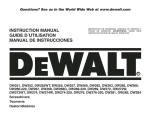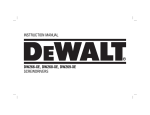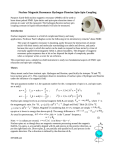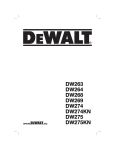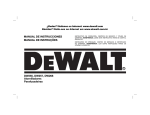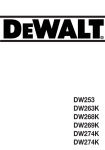Download DeWalt DW258-XE Instruction manual
Transcript
INSTRUCTION MANUAL DW251-XE, DW252-XE, DW252WT-XE, DW255-XE, DW256-XE, DW257-XE, DW258-XE, DW260-XE, DW262-XE, DW263-XE, DW265-XE, DW266-XE, DW266-220-XE, DW267-XE, DW268-XE, DW268G-XE, DW268-220-XE, DW269-XE, DW272-XE, DW272W-XE, DW272WT-XE, DW274-XE, DW274W-XE, DW274-220-XE, DW276-XE, DW276-220-XE, DW281-XE, DW282-XE, DW284-XE SCREWDRIVERS 1. WORK AREA a. Keep work area clean and well lit. Cluttered and dark areas invite accidents. b. Do not operate power tools in explosive atmospheres, such as in the presence of flammable liquids, gases or dust. Power tools create sparks which may ignite the dust or fumes. c. Keep children and bystanders away while operating a power tool. Distractions can cause you to lose control. 2. ELECTRICAL SAFETY a. Power tool plugs must match the outlet. Never modify the plug in any way. Do not use any adapter plugs with earthed (grounded) power tools. Unmodified plugs and matching outlets will reduce risk of electric shock. b. Avoid body contact with earthed or grounded surfaces such as pipes, radiators, ranges and refrigerators. There is an increased risk of electric shock if your body is earthed or grounded. c. Do not expose power tools to rain or wet conditions. Water entering a power tool will increase the risk of electric shock. d. Do not abuse the cord. Never use the cord for carrying, pulling or unplugging the power tool. Keep cord away from heat, oil, sharp edges or moving parts. Damaged or entangled cords increase the risk of electric shock. e. When operating a power tool outdoors, use an extension cord suitable for outdoor use. Use of a cord suitable for outdoor use reduces the risk of electric shock. 3. PERSONAL SAFETY a. Stay alert, watch what you are doing and use common sense when operating a power tool. Do not use a power tool while you are tired or under the influence of drugs, alcohol or medication. A moment of inattention while operating power tools may result in serious personal injury. b. Use safety equipment. Always wear eye protection. Safety equipment such as dust mask, non-skid safety shoes, hard hat, or hearing protection used for appropriate conditions will reduce personal injuries. c. Avoid accidental starting. Ensure the switch is in the off position before plugging in. Carrying power tools with your finger on the switch or plugging in power tools that have the switch on invites accidents. Definitions: Safety Guidelines The definitions below describe the level of severity for each signal word. Please read the manual and pay attention to these symbols. DANGER: Indicates an imminently hazardous situation which, if not avoided, will result in death or serious injury. WARNING: Indicates a potentially hazardous situation which, if not avoided, could result in death or serious injury. CAUTION: Indicates a potentially hazardous situation which, if not avoided, may result in minor or moderate injury. CAUTION: Used without the safety alert symbol indicates a potentially hazardous situation which, if not avoided, may result in property damage. IF YOU HAVE ANY QUESTIONS OR COMMENTS ABOUT THIS OR ANY DEWALT TOOL, CALL US AT: 1800 654 155 (Aust) or 09 259 1111 (NZ). SAFETY INSTRUCTIONS FOR POWER TOOLS When using power tools, always observe the safety regulations applicable in your country to reduce the risk of fire, electric shock and personal injury. Read the following safety instructions before attempting to operate this product. Keep these instructions in a safe place. General Safety Rules WARNING! Read all instructions. Failure to follow all instructions listed below may result in electric shock, fire and/or serious injury. The term “power tool” in all of the warnings listed below refers to your mains operated (corded) power tool or battery operated (cordless) power tool. SAVE THESE INSTRUCTIONS 1 d. Remove any adjusting key or wrench before turning the power tool on. A wrench or a key left attached to a rotating part of the power tool may result in personal injury. e. Do not overreach. Keep proper footing and balance at all times. This enables better control of the power tool in unexpected situations. f. Dress properly. Do not wear loose clothing or jewellery. Keep your hair, clothing and gloves away from moving parts. Loose clothes, jewellery or long hair can be caught in moving parts. g. If devices are provided for the connection of dust extraction and collection facilities, ensure these are connected and properly used. Use of these devices can reduce dust related hazards. 4. POWER TOOL USE AND CARE a. Do not force the power tool. Use the correct power tool for your application. The correct power tool will do the job better and safer at the rate for which it was designed. b. Do not use the power tool if the switch does not turn it on and off. Any power tool that cannot be controlled with the switch is dangerous and must be repaired. c. Disconnect the plug from the power source before making any adjustments, changing accessories, or storing power tools. Such preventive safety measures reduce the risk of starting the power tool accidentally. d. Store idle power tools out of the reach of children and do not allow persons unfamiliar with the power tool or these instructions to operate the power tool. Power tools are dangerous in the hands of untrained users. e. Maintain power tools. Check for misalignment or binding of moving parts, breakage of parts and any other condition that may affect the power tools operation. If damaged, have the power tool repaired before use. Many accidents are caused by poorly maintained power tools. f. Keep cutting tools sharp and clean. Properly maintained cutting tools with sharp cutting edges are less likely to bind and are easier to control. g. Use the power tool, accessories and tool bits etc., in accordance with these instructions and in the manner intended for the particular type of power tool, taking into account the working conditions and the work to be performed. Use of the power tool for operations different from those intended could result in a hazardous situation. 5. SERVICE a. Have your power tool serviced by a qualified repair person using only identical replacement parts. This will ensure that the safety of the power tool is maintained. Electrical Safety The electric motor has been designed for one voltage only. Always check that the power supply corresponds to the voltage on the rating plate. 240 V AC means your tool will operate on alternating current. As little as 10% lower voltage can cause loss of power and can result in overheating. All DEWALT tools are factory tested; if this tool does not operate, check the power supply. Your DEWALT tool is double insulated, therefore no earth wire is required. • Young children and the infirm. This appliance is not intended for use by young children or infirm persons without supervision. Young children should be supervised to ensure that they do not play with this appliance. • Replacement of the supply cord. If the supply cord is damaged, it must be replaced by the manufacturer or an authorised DEWALT Service Centre in order to avoid a hazard. Extension Cords CAUTION: Use only extension cords that are approved by the country’s Electrical Authority. Before using extension cords, inspect them for loose or exposed wires, damaged insulation and defective fittings. Replace the cord if necessary. MINIMUM GAUGE FOR CORD SETS For Cable length (m): 7.5 15 25 30 45 60 Use Cable with minimum rating (Amperes) Tool Amperes 0 - 3.4 7.5 7.5 7.5 7.5 7.5 7.5 3.5 - 5.0 7.5 7.5 7.5 7.5 10 15 5.1 - 7.0 10 10 10 10 15 15 7.1 - 12.0 15 15 15 15 20 20 12.1 - 20.0 20 20 20 20 25 – 2 Additional Safety Instructions WARNING: ALWAYS wear proper personal hearing protection that conforms to ANSI S12.6 (S3.19) during use. Under some conditions and duration of use, noise from this product may contribute to hearing loss. • The label on your tool may include the following symbols. The symbols and their definitions are as follows: V ................. volts A ...............amperes Hz ............... hertz W ..............watts min ............. minutes ...........alternating current no ..............no load speed .......... direct current .............. Class I Construction .............earthing terminal ................... (grounded) .............safety alert symbol ............... Class II Construction …/min .......revolutions per minute ................... (double insulated) BPM ..........beats per minute • Hold tool by insulated gripping surfaces when performing an operation where the cutting tool may contact hidden wiring or its own cord. Contact with a “live” wire will make exposed metal parts of the tool “live” and shock the operator. • Keep handles dry, clean, free from oil and grease. It is recommended to use rubber gloves. This will enable better control • Keep tool dry from sweat during use. Reduce risk of electric shock by preventing perspiration or other liquids from entering the tool during use in hot/humid conditions. Use wristbands, gloves, drying towels or cloths as necessary. WARNING: ALWAYS use safety glasses. Everyday eyeglasses are NOT safety glasses. Also use face or dust mask if cutting operation is dusty. ALWAYS WEAR CERTIFIED SAFETY EQUIPMENT: • ANSI Z87.1 eye protection (CAN/CSA Z94.3), • ANSI S12.6 (S3.19) hearing protection, • NIOSH/OSHA/MSHA respiratory protection. WARNING: Some dust created by power sanding, sawing, grinding, drilling, and other construction activities contains chemicals known to cause cancer, birth defects or other reproductive harm. Some examples of these chemicals are: • lead from lead-based paints, • crystalline silica from bricks and cement and other masonry products, and • arsenic and chromium from chemically-treated lumber (CCA). Your risk from these exposures varies, depending on how often you do this type of work. To reduce your exposure to these chemicals: work in a well ventilated area, and work with approved safety equipment, such as those dust masks that are specially designed to filter out microscopic particles. • Avoid prolonged contact with dust from power sanding, sawing, grinding, drilling, and other construction activities. Wear protective clothing and wash exposed areas with soap and water. Allowing dust to get into your mouth, eyes, or lay on the skin may promote absorption of harmful chemicals. WARNING: Use of this tool can generate and/or disburse dust, which may cause serious and permanent respiratory or other injury. Always use NIOSH/OSHA approved respiratory protection appropriate for the dust exposure. Direct particles away from face and body. COMPONENTS Switch FIG. 1 To start tool, depress the trigger switch, shown in Figure 1. To stop tool, release the switch. The variable speed trigger switch permits speed control. The farther the trigger switch is depressed, the higher the speed of the tool. To lock the switch in the on position for continuous operation, depress the trigger switch and push up the locking button. The tool will continue to run. To turn the tool off, from a locked on condition, squeeze and release the trigger once. Before using the tool (each time), be sure that the locking button release mechanism is working freely. WARNING: Be sure to release the locking mechanism before disconnecting the plug from the power supply. Failure to do so will cause the tool to start immediately the next time it is plugged in. Damage or injury could result. 3 NOTE: Align ribs on inside of depth locator with grooves in clutch housing before snapping into place. CHANGING BIT TIP 1. Pull forward on adjustment collar and remove it from clutch housing (Fig. 3). The reversing lever is used to reverse the tool for backing out screws. It is located above the trigger, shown in Figure 1. To reverse the screwdriver, turn it off and push the reversing lever to the right (when viewed from the back of the tool). To position the lever for forward operation, turn the tool off and push the lever to the left. Dead Spindle Action FIG. 3 All DEWALT screwdrivers provide a dead output spindle to permit fasteners to be located easily in the driving accessory. Clutches are held apart by light spring pressure permitting the driving clutch to rotate without turning the driven clutch and accessory. When sufficient forward pressure is applied to the unit, the clutches engage and rotate the spindle and accessories. A reversing switch makes it possible to drive or loosen either right or left hand screws. Accessory Assembly FIG. 2 2. Use pliers to remove worn bit and install new bit tip. DEPTH ADJUSTMENT Follow the graphic on the collar to increase or decrease the fastening depth. To seat the screw deeper in the workpiece, turn the adjustment collar to the right. To seat the screw higher in the workpiece, turn the adjustment collar to the left. The 6.35 mm (1/4") hex drive ball lock chuck is used on all depth sensitive and drywall screwdrivers. Assemble accessories by engaging the hex spindle and tapping lightly on the accessory until it snaps in place. Usually pliers are required to remove the accessory by pulling forward. The 6.35 mm (1/4") hex drive quick change chuck (Fig. 2), is used on all Versa Clutch™ units. A ball retainer provides positive locking of all accessories in the chuck. Pull forward on the ball retainer and hold while inserting or removing accessories. Release for positive accessory retention. Nutsetting Units (DW260-XE, DW263-XE, DW266-XE, DW266-220-XE) INSTALLING AND CHANGING NUTSETTERS AND LOCATORS Depth Sensitive Units for Drill Point Screws 1. To change or install a new nutsetter: a. Pull forward on adjustment collar and remove from clutch housing. b. Pull nutsetters straight out with pliers c. Select nutsetter size desired. d. Two locators are supplied, a 14.3 mm (9/16") ID for 3/8" nutsetters and 12.7 mm (1/2") ID for 5/16" nutsetters. Match locator to desired size nutsetter or bit holder. Depth Sensitive Units (DW251-XE, DW252-XE, DW255-XE, DW256-XE, DW257-XE, DW258-XE, DW262-XE, DW265-XE, DW272-XE, DW274-XE, DW274W-XE, DW274-220-XE, DW276-XE, DW276-220-XE) TO CHANGE BIT HOLDERS 1. Pull forward on adjustment collar and remove from clutch housing. 2. Pull bit holder straight out with pliers if it is difficult to remove. 3. Push new bit holder into spindle until ball lock snaps in groove in bit holder shank. 4. Replace adjustment collar by snapping over retaining ring. 4 FIG. 4 NUTSETTER 2. Place nutsetter into clutch housing and push end of nutsetter until ball lock snaps into groove of nutsetter shank. 3. Reassemble adjustment collar by snapping over springs (Fig. 4). NOTE: Align ribs on inside of depth locator with grooves in clutch housing. DEPTH ADJUSTMENT 1. For washer head screws: rotate adjustment collar until end of nutsetter is flush with end of locator. 2. For large washer head and sealer screws: adjust as above until nutsetter is recessed approximately 1.6 mm (1/16") into the locator. 3. Test drive a fastener in scrap material to determine if seating is correct. 4. Adjust following the graphic printed on the tool. VERSA CLUTCH™ UNITS (DW267-XE, DW268-XE, DW268-220-XE, DW268G-XE, DW269-XE) External adjustment of all Versa Clutch™ units for a wide range of fastener sizes is fast and easy as follows (Fig. 5): 1. Pull forward, then rotate collar in increase direction (stamped on adjustment collar) to increase the amount of clutch engagement and torque output. 3. Test drive a fastener into a scrap piece to check proper fastener seating. It is normal after a period of use to require a slightly different collar setting due to wear on the clutch faces. NOTE: With Versa Clutch™, the operator has the ability to “override” clutch ratchet if a fastener hits a wood knot, variable hardness in steel work pieces or incorrect pilot holes. Increased operator pressure will usually cause the clutches to pick-up and continue to seat the fastener. Further, a quick twist of the collar will change the clutch setting to overcome most driving difficulties and will provide for immediate change in torque output giving the operator the option to drive a wide range of fastener sizes. Positive Clutch Units (DW281-XE, DW282-XE, DW284-XE) 1. Install proper bit and set screwdriver for correct rotation. 2. Place fastener on bit and contact work. 3. Apply steady pressure on screwdriver to keep clutches engaged and bit in contact with fastener. 4. Upon fastener seating, clutches will ratchet. Disengage bit from fastener. MAINTENANCE WARNING: Shock Hazard. To reduce the risk of serious personal injury, turn tool off and disconnect tool from power source before making any adjustments or removing/installing attachments or accessories. FIG. 5 Cleaning WARNING: Blow dirt and dust out of all air vents with dry air at least once a week. Wear proper ANSI Z87.1 (CAN/CSA Z94.3) eye protection and proper NIOSH/OSHA/ MSHA respiratory protection when performing this. WARNING: Never use solvents or other harsh chemicals for cleaning the nonmetallic parts of the tool. These chemicals may weaken the plastic materials used in these parts. Use a cloth dampened only with water and mild soap. Never let any liquid get inside the tool; never immerse any part of the tool into a liquid. DRYWALL SCREWDRIVERS: Depth locator and adjustment collar should be removed and drywall dust blown out of the clutch housing area at least once a week. VERSA CLUTCH™ 2. Maximum rotation of the collar in the increase direction results in full clutch engagement and maximum torque output and fastener capacity. Collar and adjustable stop will not screw off clutch housing. 5 Changing Clutches Recommended accessories for use with your tool are available at extra cost from your local service center. If you need any assistance in locating any accessory, please contact DEWALT Industrial Tool Co., 20 Fletcher Road, Mooroolbark, VIC 3138 Australia or call 1800 654 155 or (NZ) 09 259 1111. FIG. 6 1. Remove clutch housing by unscrewing (left hand thread). 2. Clamp tool or clutch housing in a resilient clamp. USE CARE, the clutch housing can be easily damaged. 3. Remove round clutch retaining rings with a very small screwdriver (Fig. 6). 4. Install new clutches and new retaining rings. (DW274 series only) Be careful to assemble the intermediate clutch large end first toward the unit and then the spring. The spring should run against the output clutch. NOTE: If the output spindle slides toward inside of gear case, remove gear case and push output spindle forward to expose retaining ring groove. Reassemble dead spindle spring allowing no more than 6.35 mm (1/4") projecting from end of spindle. 5. Relubricate clutches. Guarantee Applicable to hand held Power Tools, Lasers and Nailers. Three Year Limited Warranty DEWALT will repair, without charge, any defects due to faulty materials or workmanship for three years from the date of purchase. Please return the complete unit, transportation prepaid, to any DEWALT Service Centre, or any authorised service station. For warranty repair information, call (AUS) 1800 654 155 or (NZ) 09 259 1111. This warranty does not apply to • Accessories • Damage caused where repairs have been made or attempted by others. • Damage due to misuse, neglect, wear and tear, alteration or modification. This warranty gives you specific legal rights and you may have other rights under the provisions of the Consumer Guarantee Act 1993 (New Zealand only), Trade Practices Act 1974 and State Legislation (Australia only). In addition to the warranty, DEWALT tools are covered by our: FREE ONE YEAR SERVICE CONTRACT DEWALT will also maintain the tool for free at any time during the first year of purchase. This includes labour, parts and lubrication required to restore the product to sound mechanical and/or electrical condition. Normal wear parts are not covered in this service. Carbon brushes worn more then 50% will be replaced. NOTE: Three Year Warranty is not applicable to items deemed as consumables. Radial arm saws are covered by a one (1) year warranty only. DEWALT Reserves the right to review its warranty policy prior to launch of any new business development products. 30 DAY NO SATISFACTION GUARANTEE If you are dissatisfied with any DEWALT power tool, laser or nailer, for any reason, simply return it to the point of purchase with your sales receipt within 30 days for a replacement unit or a full refund. Lubrication All ball and needle bearings are factory lubricated for the life of the bearing. CLUTCH LUBRICATION 1. Remove clutch housing by unscrewing (left-hand thread). 2. Lightly brush clutch faces. Repairs To assure product SAFETY and RELIABILITY, repairs, maintenance and adjustment (including brush inspection and replacement) should be performed by certified service centers or other qualified service organizations, always using identical replacement parts. ACCESSORIES WARNING: Since accessories, other than those offered by DEWALT, have not been tested with this product, use of such accessories with this tool could be hazardous. To reduce the risk of injury, only DEWALT, recommended accessories should be used with this product. 6 FREE WARNING LABEL REPLACEMENT: If your warning labels become illegible or are missing, call (AUS) 1800 654 155 or (NZ) 09 259 1111 for a free replacement. 7 8 9 DEWALT Industrial Tool Co., 20 Fletcher Road, Mooroolbark, VIC 3138 Australia (03 8720 5100) • 5 Te Apunga Place, Mt Wellington, New Zealand (09 259 1111) (OCT07) Part No. 1007746-00 DW251-XE, etc. Copyright © 2007 DEWALT The following are trademarks for one or more DEWALT power tools: the yellow and black color scheme; the “D” shaped air intake grill; the array of pyramids on the handgrip; the kit box configuration; and the array of lozenge-shaped humps on the surface of the tool.














